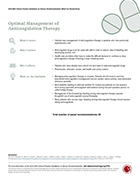ASH VTE Guidelines: Anticoagulation Therapy
In July 2022, these guidelines were reviewed by an expert work group convened by ASH. Review included limited searches for new evidence and discussion of the search results. Following this review, the ASH Committee on Quality agreed to continue monitoring the supporting evidence rather than revise or retire these guidelines at this time. Limited searches and expert review will be repeated annually going forward until these guidelines are revised or retired.
Clinicians confront numerous practical issues in optimizing the use of anticoagulants to treat VTE. Anticoagulant therapy is complex and associated with substantial benefits and risks. These guidelines focus on the optimal management of anticoagulant drugs for the prevention and treatment of VTE following the choice of an anticoagulant.
Access the full guidelines on the Blood Advances website:
Guideline Implementation Tools and Resources
ASH guidelines are reviewed annually by expert work groups convened by ASH. Resources derived from guidelines that require updating are removed from the ASH website.
VTE Guidelines: What You Should Know
This one-page snapshot provides a high-level summary of the VTE guidelines for optimal care management of anticoagulation therapy in patients who have previously experienced a clot. A snapshot of the full VTE guidelines is also available for download.
ASH Clinical Practice Guidelines App
The ASH Clinical Practice Guidelines App provides easy access to every recommendation from all guidelines published by ASH, including rationale for each recommendation, benefits and harms associated with each recommended course of action, and links to the complete evidence-to-decision tables used to develop the recommendations. This app is also available via web interface.
Download for iOS Download for Android
Pocket Guides
Available on iOS, Android, and via the web, the ASH Pocket Guides App includes all of ASH’s pocket guides, including the 2019 pocket guide on the Management of Anticoagulation Therapy, which is available for order in printed format at the ASH Store.
- Management of Anticoagulation Therapy
ASH Store | Download PDF - not for distribution
Teaching Slides
Help your colleagues diagnose, manage, and treat VTE with the following teaching slides designed for easy dissemination:
- Teaching slides for optimal management of anticoagulation therapy
Powerpoint | PDF
Podcast
Listen to the podcast below to learn more about ASH's anticoagulation therapy guidelines.
VTE PATIENT STORIES

Juliet Mock, a 38-year-old registered nurse living in Wisconsin, first learned about venous thromboembolism (VTE) at the age of 14 when she lost her aunt to a pulmonary embolism. It was discovered that her aunt had two genetic risk factors associated with VTE, factor V Leiden and protein c deficiency. Juliet and her immediate family members were tested, and it turned out Juliet also has the same risk factors but was told not to worry until she decided to have children.
In 2008, Juliet had her first born, a daughter. Her newborn baby ended up in the NICU for seven weeks due to an issue with her lungs. While sitting in the NICU for eight to 12 hours per day with her child, Juliet experienced a pain in her leg. Although she knew the symptoms of a blood clot, she didn’t see any visible swelling and pushed the pain aside. One night, Juliet tried to stand up but could not put pressure on her leg. Her husband insisted they see a doctor, and at the hospital a blood clot was discovered in Juliet’s leg.
Fortunately, Juliet and the doctors were able to treat the clot. She has since been on blood thinners and has not experienced another one . “You would think I’d have known better than to ignore the symptoms of VTE since I’m a nurse and take care of patients with blood clots. I was so focused on my child that I wasn’t taking care of myself,” she said.
Today, when she’s not using her experience to educate patients about the signs, symptoms, and risk factors of VTE, Juliet focuses on her spouse of 14 years and two children, including her “mini me” daughter, who also has inherited a genetic risk factor for VTE. Juliet is comforted knowing there are so many experts out there identifying the right treatments and care for patients with VTE.

Tarra Myers, a 40-year-old construction worker from Canada, discovered she had venous thromboembolism (VTE) in 2011. Tarra had noticed her leg getting larger and larger but wrote it off as a twisted ankle. The next day, she was very lightheaded and had difficulty focusing. As the days went by, she could hardly walk without being lightheaded and noticed her leg continuing to grow in size. Finally, Tarra decided to go to the hospital.
“Had I thought this through and analyzed the situation, I would have gone to the hospital a lot sooner,” Tarra said. Once she got to the hospital, the doctor told Tarra she had deep-vein thrombosis (DVT), a blood clot that forms in a deep vein, in her left leg. She was prescribed anticoagulants.
It was revealed Tarra has a genetic predisposition to clotting, so the doctor decided to keep her on the anticoagulants long term. Fortunately, Tarra has not experienced another blood clot.
Tarra says that education for the patient essential after being diagnosed with VTE. She especially believes it is important to educate teenagers and young adults, who may be even less familiar with signs, symptoms, and risk factors.
Patient Versions of the Guidelines
- Blood clots when you are pregnant or breastfeeding
- Heparin-induced thrombocytopenia
- Preventing a blood clot
- Testing for blood clots
- Things to know if you are taking a blood thinner to prevent blood clots
